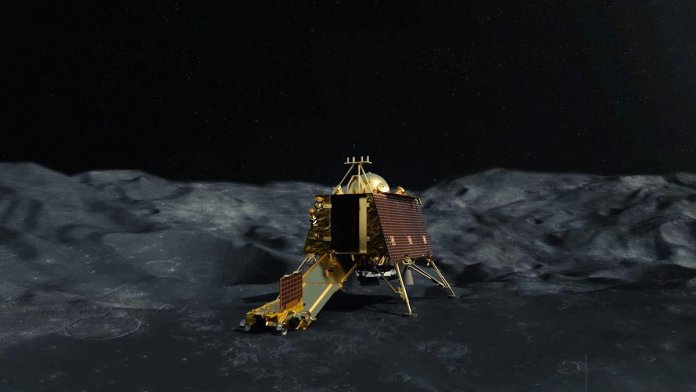The Lunar Science Workshop 2021 is a two-day workshop, organised by Indian Space Research Organisation (ISRO). ISRO Chairman, K.Sivan inaugurated the workshop on September 6, 2021 to honour the Chandrayaan-2 orbiter’s two-year operation around the lunar orbit. It was live-streamed on the ISRO website, social media platform, and YouTube channel. He also released the documents on Chandrayaan-2 science results and data products for utilization by the scientific community.
About Chandrayaan- 2
It is the second spacecraft in India’s Lunar Exploration Satellites series. It consisted of an orbiter, a lander named Vikram, and a rover named Pragyan, all of which were designed to explore the Moon’s undiscovered South Polar area.
It was launched on 22nd July, 2019 from the Sriharikota spaceport by GSLV Mk-III.
It was inserted into a lunar orbit in August, 2019.
In September 2019, the orbiter and lander components were separated into two separate satellites.
Failure of the lander
The Vikram lander’s descent went according to plan, with normal performance up to a height of 2.1 km above the lunar surface in September 2019. However, communication from the lander was lost and it made a rough landing on the lunar surface.
A successful soft-landing would have made India the fourth country after the Soviet Union, the United States, and China to do so.
The orbiter
The six-wheeled Pragyan rover was accommodated inside the Vikram lander.
Using its eight advanced scientific equipment, the orbiter gave an insight of the Moon’s evolution and mapping of minerals and water molecules in polar regions after being positioned in its intended orbit around the Moon.
The orbiter has a life of approximately seven years instead of the expected one year due to the precise launch and optimised mission management.
Findings of Chandrayaan 2 Orbiter
Detection of Chromium and Manganese: The Chandrayaan-2 Large Area Soft X-ray Spectrometer (Class) analysed the lunar X-ray fluorescence (XRF) spectra for the presence of key elements including magnesium, aluminium, silica, iron, calcium, titanium and sodium.
Detection of Argon-40: From a polar orbital platform, the mass spectrometer CHandra’s Atmospheric Compositional Explorer 2 (CHACE 2) performed the first-ever in-situ analysis of the composition of the lunar neutral exosphere.
It identified and examined the variations of Argon-40 at the Moon’s middle and higher latitudes, representing radiogenic activities in the Lunar interior’s middle and higher latitudes.
Subsurface Water-ice Detection: The Dual Frequency Synthetic Aperture Radar (DFSAR) instrument discovered subsurface water-ice signs and produced high-resolution mapping of lunar morphological characteristics in the polar regions.
Microflares of the Sun Observations: The Solar X-ray Monitor (XSM) payload made observations of microflares of the Sun during the quiet-Sun phase, which provide vital hints on the Sun’s coronal heating problem.
Detection of Hydration Characteristics: Chandrayaan-2 achieved the first-ever unambiguous identification of the Moon’s hydration features with its Imaging Infrared Spectrometer (IIRS) payload, which captured clear evidence of Hydroxyl and water-ice on the lunar surface.
Findings in Geology: Chandrayaan-2’s Terrain Mapping Camera (TMC 2), which is mapping the Moon on a global scale, has discovered interesting geologic indications of lunar crustal shortening as well as the identification of volcanic domes.
Imaging the Moon: The Orbiter High Resolution Camera captured images of the moon from a 100 km lunar orbit with “best-ever” resolution of 25 cm (OHRC).
Significance of the latest Chandrayaan-2 data
K Sivan stated that Chandrayaan-2 will be able to assist in better understanding the evolution of the inner solar system since the Moon, as an airless celestial body, has preserved the signatures of events that occurred in the solar system’s early years.
The results are very encouraging and the entire scientific community in this country will be able to use the information to discover new research that has yet to be discovered.
ISRO is likely to launch Chandrayaan-3 in 2022. Read our blog on Chandrayaan-3 to know more about it.




